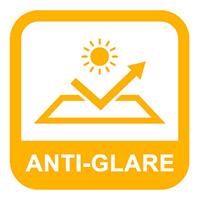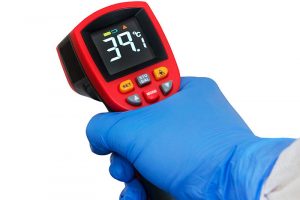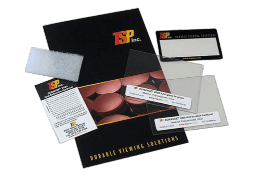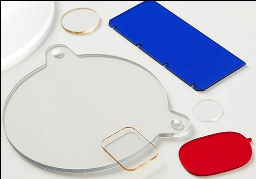Anti-Glare vs. Anti-Reflective
What is the difference between anti-glare and anti-reflective?
Glare and reflection are terms often confused for each other. So how do you decide whether you need an anti-glare or anti-reflective solution to your viewing problem? Let us try to help.

Readability is what you really want
Both anti-glare and anti-reflective treatments represent ways to improve or optimize readability of a displayed image or set of characters. Readability is essential for the optimum performance of any display, and you want the visual information to be read clearly, quickly and comfortably (minimal eyestrain). Both anti-glare and anti-reflective methods improve readability, but attack the problem using different mechanisms to address the different causes of reduced readability.
External reflection and coherence of the reflected image
 Anti-Glare deals with external sources of reflection off a surface – like bright sunlight or high ambient lighting conditions – and its impact on the readability of the image or information you are trying to read.
Anti-Glare deals with external sources of reflection off a surface – like bright sunlight or high ambient lighting conditions – and its impact on the readability of the image or information you are trying to read.
To deal with the external sources of reflection, Anti-Glare uses diffusion mechanisms to breakup the reflected light off the surface. Diffusion works by reducing the coherence of the reflected image, making these unwanted images unfocused to the eye, thereby reducing their interference with viewing of the intended image contained in the display.
Glare reduction and image resolution
The principle drawback to using diffuse mechanisms to address external reflection (glare) has been that they sacrifice clarity and resolution of the intended image. Mechanically or chemically textured surfaces – or anti-glare coatings using suspended particules – reduce the glare, but often at a significant trade off in image resolution and readability. While economical to apply, the trade-off in image resolution represented by these anti-glare treatments often makes them an inferior solution to your viewing requirements.

TSP’s DURAVUE® 2000 High Resolution Anti-Glare Hardcoat is different, as it is unique in its ability to diffuse reflected light with minimal sacrifice to the clarity and resolution of the displayed image. Our proprietary coating process yields an anti-glare surface with superior image resolution at any given level of glare reduction versus other diffusion anti-glare offerings, while remaining much more economical than the expensive AR type solutions listed below.
Anti-Reflection
 Unlike diffusion-based anti-glare solutions, Anti-Reflection considers all sources, both internal and external, that accumulate to reduce the light transmitted through the display window, thereby reducing the readability of the viewed image or information. As light passes from one medium to another, be it from air to solid or between solid layers, the difference between the “index of refraction” in the adjacent mediums creates transitional phase differences, thereby increasing the amount of light reflected. These reflections are cumulative, and can “wash out” the display, making the image unreadable without increasing the light output via expensive power increases.
Unlike diffusion-based anti-glare solutions, Anti-Reflection considers all sources, both internal and external, that accumulate to reduce the light transmitted through the display window, thereby reducing the readability of the viewed image or information. As light passes from one medium to another, be it from air to solid or between solid layers, the difference between the “index of refraction” in the adjacent mediums creates transitional phase differences, thereby increasing the amount of light reflected. These reflections are cumulative, and can “wash out” the display, making the image unreadable without increasing the light output via expensive power increases.
To combat this problem, thin multi-layer Anti-Reflective optical films or coatings like TSP’s DURAVUE® 7000 are applied to “bend” the light through each medium, providing broadband reduction of reflection across the visible light spectrum, increasing the total light transmission to as high as 99.5%. DURAVUE® 7000 is as effective as these other AR films in reducing reflection, but with the added feature of being durable to withstand repeated cleanings without the scratching and smudging common to most AR surface treatments.
For more discussion on this topic, or to have us build you a DURAVUE® solution optimized for your specific viewing problem, please contact us today!

 Anti-Glare Plastic for Displays
Anti-Glare Plastic for Displays  Which is the best material to use for your display or data acquisition window?
Which is the best material to use for your display or data acquisition window?  DURAVUE® Coatings allow for the use of Plastics for Viewing & Data Acquisition Applications
DURAVUE® Coatings allow for the use of Plastics for Viewing & Data Acquisition Applications  Looking to improve the readability of your outdoor signs and displays?
Looking to improve the readability of your outdoor signs and displays?  See it for yourself! Kit contains hardcoated plaques with each of our DURAVUE® coatings.
See it for yourself! Kit contains hardcoated plaques with each of our DURAVUE® coatings.
 Need a pre-production sample? Let us provide you with a fully functional prototype window.
Need a pre-production sample? Let us provide you with a fully functional prototype window.
 Tell us about your project and we’ll provide you with a budgetary quotation.
Tell us about your project and we’ll provide you with a budgetary quotation.